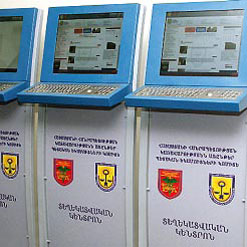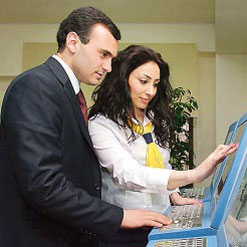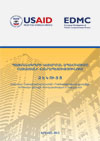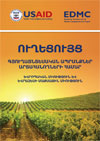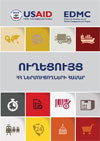Value added TAX
Value added TAX
Introduction
In Armenia persons subject to VAT deduct the VAT paid on their inputs from the VAT charged on their sales and account for the difference to the tax authorities. The standard rate of VAT on domestic sales of goods and services and the importation of goods is 20%. Exported goods and related services are zero-rated.
Taxable threshold
VAT obligations are based on taxable turnover for transactions implemented during the previous calendar year. If those revenues exceed AMD 58.35 million, the taxpayer must account for VAT on all sales. Generally, if the previous year’s revenues were less than AMD 58.35 million (e.g., the taxpayer is in the frst year of operations), the taxpayer is obliged to account for VAT only on sales in that year that exceed AMD 58.35 million. Taxpayers whose revenues are below the AMD 58.35 million threshold may voluntarily elect to account for VAT.
Scope of VAT
Unless there is an express exemption in the law, VAT applies to:
- Goods and services where the place of supply is Armenia, and
- Importation of goods into Armenia.
Origination of goods
The origination of goods for VAT purposes is the place where the goods are located when they are sold. For goods that are to be delivered, the supply takes place where the goods are located when they are dispatched.
Origination of services
As a general rule for VAT purposes services are supplied in the place where the service provider performs the service. If the place of performance is uncertain, services are considered to be supplied in the place where the person’s business is located. Specifc rules for this purpose apply to the following services:
- Services related to real estate are supplied in the place where the real estate is located.
- Transportation services are supplied in the place where the transportation passengers or cargo originates.
- Services related to culture, art, sport, science, education and public health, ancillary support for transportation, and the assessment or repair of movable property are supplied in the place where the services are performed.
- The lease of transportation vehicles is supplied in the place where the lessor implements business activity, or if no such place exists, in the place of domicile or residence of the lessor.
- Cross-border postal and telecommunication services are supplied in the country of destination.
- They are supplied in the place where the recipient of the services implements business activity or has a permanent offce (i.e., if the recipient has a permanent offce in Armenia, the services are subject to VAT).
- If the recipient does not implement business activity and has no permanent offce, the services are supplied in the place of residence of the recipient.
VAT on importation
Unless expressly exempted under the law, imported goods are subject to 20% VAT during customs clearance. Special rules apply to goods that were exported earlier from Armenia to be processed or repaired. In that case, VAT is imposed based on the value of the service performed by the foreign party. If it is not possible to determine the value of the service, VAT is imposed based on the difference between the customs value of the goods after processing or repair and their declared customs value when they were exported.
Zero rating
The export of goods and the supply of services that are ancillary to the export of goods are zero-rated. Zero-rating also applies to the supply of international transport services (including transit through Armenia) and toll manufacturing services. Advertising, consulting, engineering, legal, accounting, translation, data processing, banking, fnancial and insurance services provided to non-residents are zero-rated if the non-resident’s place of business is outside Armenia.
Exempt supplies
Armenian law distinguishes VAT-exempt transactions from transactions that are outside the scope of VAT. From a practical perspective, however, the distinction is not important. In either case, a person making such sales will not be entitled to claim an input tax credit against those sales. A number of transactions are exempt from VAT. Some of the more common exemptions are most fnancial transactions carried out by fnancial organizations; tuition services for secondary, professional, and high schools; and ale of education materials; sales of newspapers and magazines. The sale of ownership rights in an entity or business, as well as transactions for the reorganization of an entity or business, are not subject to VAT.
Taxable amount
In most cases, the amount of VAT will be determined based on the transaction price for the supply of goods or services. When goods and services are provided free of charge, the supplier is required to account for VAT based on the market value of the goods or services, unless the supply involves warranty services provided by a seller of goods, replacement of defective goods.
Non-deductible input VAT Obligations
The general rules for VAT input tax credits are:
- VAT paid on goods and services that will be used to make taxable sales may be claimed as an input tax credit.
- VAT incurred to purchase or import goods and services that will be used to make sales that are VAT-exempt or not subject to VAT may not be claimed as a credit.
- When goods and services will be used to make partly taxable and partly non-taxable sales, the input tax credit is apportioned between the taxable and non-taxable sales based on the proportion of taxable sales to total sales for each reporting period.
A claim for input tax must be supported by a valid VAT invoice issued by a supplier or a duly executed import customs declaration. In addition, for the purchase of goods or services, an input tax credit will generally only arise if payment is remitted through a bank and the goods or services are obtained for commercial purposes. Input tax credits are available for cash purchases, but only up to AMD 300,000 per transaction and up to a maximum of AMD 3 million per month, and provided that all necessary VAT information is included on the sales receipt or the VAT invoice. Generally, VAT paid that is not able to be claimed as input tax credit is treated as part of the cost of acquisition for purposes of proft tax or income tax.
VAT compliance
Registration
The following taxpayers are automatically required to account for VAT:
- Businesses with sales exceeding AMD 58.35 million in the preceding calendar year will be required to account for VAT on their sales in the subsequent calendar year
- Businesses that require a license costing more than AMD 100,000 to operate and businesses producing excisable goods will also be required to account for VAT on their sales
- Businesses that produce or imports products that are subject to excise tax
- Other businesses will be required to account for VAT on any sales in a calendar year in excess of AMD 58.35 million
- Special rules exist that may require inter-related persons (mutual ownership in statutory capital, proportion of income or expenses related to one supplier or customer) to account for VAT because of their relationship.
Starting from 1 January 2012, VAT payers are required to obtain VAT registration numbers from the tax authority.
Accounting requirements
VAT payers are required to keep separate accounts for taxable and VAT-exempt sales and purchases. If it is not possible to keep separate accounts, the amount of VAT input tax credit for each reporting period should be calculated based on the proportion of taxable sales to total sales for that period.
Information on VAT invoice
With the exception of retail sales, a VAT-registered person is required to issue a VAT invoice for every taxable sale of goods or services. The VAT invoice should be issued either electronically or using non-transferable numbered forms obtained from the tax authorities. A tax invoice needs to have a unique series and number. When the invoiced amount exceeds AMD 100,000, information on this invoice should be reported to the tax authorities by both parties of transaction, with the exception of electronic invoices. A VAT invoice may not be issued for transactions that are exempt or not subject to VAT. Special rules also apply concerning the preparation of invoices for zero-rated sales.
VAT liability
VAT liability in any accounting period will be the total amount of output tax charged on sales, less the input VAT paid relating to taxable sales. VAT is accounted for as follows:
- VAT on the sale of goods is accounted for when the goods are unloaded or delivered to the purchaser
- VAT on the sale of services is accounted for when the services are rendered to the customers
- The entitlement to an input tax credit for purchases arises on the date on which payment is made, provided the VAT invoice is obtained before the end of the reporting period. If the invoice is obtained late, the general practice would be to fle an amended return for the period
- The entitlement to an input tax credit for imported goods arises on the date of importation.
Reverse charge
Services supplied in Armenia by non-residents that are not registered in Armenia are subject to the application of a VAT reverse charge. To support a corresponding claim for an input tax credit, the recipient of the services must self-issue an invoice on behalf of the non-resident, and indicate their own identifcation number as the supplier of services.
Returns and payments
Generally, VAT payers should fle VAT returns on a quarterly basis. However, taxpayers with sales (excluding VAT) in the previous calendar year exceeding AMD 100 million are required to fle VAT returns monthly. VAT payments must be made and VAT returns fled within 20 days following the end of the reporting period. A separate report with information on sales and purchase invoices exceeding AMD 100,000 must be fled within 20 days following the end of the reporting period. If the report is not fled, the authorities are likely to disallow input tax credits.
Refunds
As a general rule, when input tax for a reporting period exceeds output tax for the period, the excess input tax is carried forward and applied against VAT payable in future reporting periods. Refunds are permitted only for purchases and importations that are directly related to zero-rated transactions (other than the export of ferrous and non-ferrous scrap). According to law, a refund should be issued within 90 days of the refund application. Penalties are calculated and paid to the taxpayer, if excess credit is not paid within 90 days. For each overdue day after the established time period penalties will apply on the amount of excess credit and will be determined based on the interest rate defned by the Central Bank of Armenia (subject to recalculation on a daily basis).
Individual Taxation
Individual Taxation
Territoriality and residence
Individuals are classifed into two categories for income tax purposes:
- Residents are liable for tax on their worldwide income. The standard rate is applicable for most types of income, including salary, dividends, royalties and investment income
- Non-residents are liable for tax only on their Armenian source income.
Tax residence
Individuals are deemed to be residents for tax purposes in Armenia if:
- they are physically present for 183 days or more for any consecutive twelve-month period commencing or ending during the tax year,
- their center of vital interests is in Armenia, or
- they are employed in the civil service of Armenia.Individuals who do not meet these conditions are non-residents.
Tax rates
Income from royalties, interest (if not exempt), sale of property (if not exempt) and lease of property is subject to a 10% tax. If paid on behalf on an individual taxpayer by a tax agent, tax should be withheld at the source. Tax agents include Armenian legal entities, individual entrepreneurs and branches or representative offces of a foreign company.Other income paid by a tax agent is subject to fnal withholding on a monthly basis and the following rules apply:
- the frst AMD 80,000 per month of taxable income is taxed at 10%,
- additional income up to AMD 2 million is taxed at 20%,
- a 25% rate applies on income in excess of AMD 2 million.Other income not received from tax agents is taxed on an annual basis:
- the frst AMD 960,000 (approximately USD 2,460) per year of taxable income is taxed at 10%, and
- additional income is taxed at 20%.
Private entrepreneurs
s a general rule, the taxable income for individuals registered as private entrepreneurs is calculated as the difference between gross income and the documented expenses connected to the business activity. Under the general tax regime, entrepreneurs may deduct business expenses and depreciation charges subject to the rules established by the law “On Proft Tax”.
Gross income
Resident taxpayers are required to pay tax on any income received or credited in Armenia or abroad during the reporting period, except for items specifcally exempted from tax under the law.
Employment income
All income received or credited from employment in monetary form or in kind during a calendar year is subject to personal income tax. Usually income tax is withheld by a tax agent.
Income from independent activities
Income from independent activities is subject to the standard rate, unless the individual is covered by the presumptive tax rules.
Rental income
Gross revenues from property leases are subject to a 10% tax.
Income from prizes and winnings
Income in the form of prizes (other than cash prizes from the state lottery) and winnings in excess of AMD 10,000 per payment are taxed at the standard tax rate.
Investment income
Gains from the sale or exchange of shares or securities are exempt from tax. Dividends are exempt from tax. Interest income is exempt if received from state securities. In other cases, a 10% rate applies. Gross royalties are subject to a 10% tax.
Disposal of real estate and movable property
The tax treatment of disposal of property depends on the tax status of the purchaser. If the purchaser is a legal entity or an individual entrepreneur, a 10% tax should be withheld from the gross sale price. Otherwise, the income is exempt from tax.
Tax-exempt income
In addition to the exemptions indicated in the discussion on gross income, exempt income includes state benefts (with the exception of benefts for temporary work disability and for the care of a sick family member), pensions, alimony, property and cash received as an inheritance, and insurance compensation.
Deductions
Business
Documented expenses incurred directly and exclusively for the purpose of generating business income are deductible.
Non-business
A taxpayer may deduct contributions to religious, public and other non-proft organizations, up to a maximum of 5% of taxable income. An individual is also entitled to a personal allowance deduction of AMD 32,500 (equal to the current minimum salary in Armenia) for each month’s income received.
Social security contributions
Taxable income is reduced by the amount of mandatory employee contributions for social security.
Foreign tax credits
Residents are allowed to credit foreign taxes paid on income received abroad against their Armenian tax liabilities. The amount of foreign tax credit is limited to the amount of Armenian tax that would have arisen from the equivalent income in Armenia.
Taxation of non-residents
Non-residents are subject to Armenian tax only on income that originates in Armenia. For individuals, any income received from Armenian labour contracts, business activities performed in Armenia, or capital employed or property used in Armenia is defned as Armenian-sourced income.
Tax compliance
Obligations of withholding agents
Any income payment by a tax agent to an individual is subject to withholding, unless the payment is to an sole entrepreneur and the parties have signed a contract that indicates the individual’s TIN, passport data, domicile in Armenia and the number of the state registration certifcate issued when business activity commenced. If this requirement is not met, payments from commercial, non-commercial organizations and private entrepreneurs are subject to an 11% withholding tax. Withhold-ing tax from payments to individuals must be transferred to the State Budget not later than the 20th day of the month following when income was paid or salary was accrued.
Tax returns for individuals
Armenian residents who receive income that has not been subject to Armenian tax at the source are required to fle a personal tax return by 15 April of the following year. Tax obligations must be paid by May 1st.
AVOIDANCE OF DOUBLE TAXATION
Armenia had tax treaties with 35 countries in force as of January 2012. Provisions of these treaties are generally applicable automatically when a local company possesses an appropriate residency certifcate issued by foreign tax authorities. However, Armenia does not honor pre-independence tax treaties entered into by the former Soviet Union. See more detailed information in the “Multilateral and Bilateral Agreements” chapter of this guide.
Page 2 of 2
- 1
- 2













